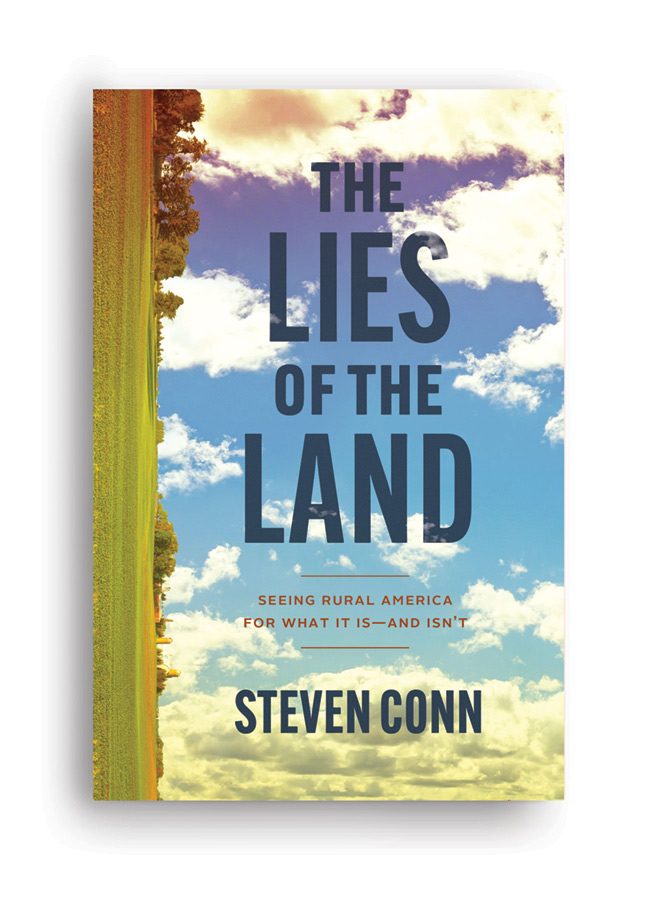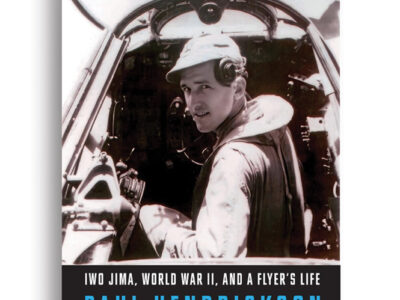The countryside looms large in America’s self-image. Should it?
By Dennis Drabelle

Land: Seeing Rural America for What
It Is—and Isn’t
By Steven Conn Gr’94
University of Chicago Press. 317 pages, $29.
Steven Conn Gr’94’s new book, The Lies of the Land, is a myth-buster that begins and ends with a swing at Thomas Jefferson’s idealization of yeoman tillers of the soil. “American pioneers and homesteaders,” Conn argues in his introduction, “far from being anchored to the land like they were supposed to be, were restless and expansive and mobile, perhaps even more so in the nineteenth century than in the twentieth. … Rural people were market oriented, commercially driven, and financially savvy from the start of the Republic.”
Some 250 pages later, the Miami (Ohio) University history professor concludes that “many Americans … project onto rural America their yearning for tight-knit community, for self-reliance and independence, neighborliness, and simpler, slower living; but that fantasy cannot accommodate the realities of life in many parts of rural America, nor does it take into account the thorough extent to which the military, industry, corporations, and suburbia have shaped rural space.” In between, Conn shows how those forces have undermined the occupants of America’s troubled countryside.
The book is replete with striking evidence and fresh insights. Take, for instance, Earl Butz, the secretary of agriculture in the Nixon and Ford administrations and one of the villains in Conn’s industrial section. Butz was so keen to replace what he viewed as the communistic New Deal approach to agriculture that he implemented policies conducive to massive crop surpluses—the perverse effect of which was to encourage further overproduction because farmers had to grow even more of a commodity to offset falling prices caused by the glut.
Among the results were crops treated with ever-increasing doses of fertilizer and pesticides, the transformation of excess corn into high-fructose corn syrup, and the use of excess soybeans in a welter of products, including animal feed and the “milk” poured into a Starbucks latte. “That we are awash in processed foods, with all the implications they have had for our health,” Conn sums up, “can be traced to the Butzian imperative to grow more.”
Or consider Cal Turner, the founder of Dollar General, a discount store chain that at the time Conn was writing had some 18,000 outlets. Turner’s trick was to get hold of “discontinued items, closeouts, slightly damaged items, out-of-season goods” and sell them cheaply from rented buildings in the American boondocks. The company typically obtains short-term leases for its stores, so that unprofitable ones can be here today, gone tomorrow.
While in operation, the stores are so understaffed that they attract thieves and play host to violence. Conn reports that “fifty people were killed in Dollar General stores between 2017 and 2020.” You might have already guessed that Dollar General is also a tight-fisted employer—while a store’s customers are buying goods at cut rates, the too-few employees are getting paid the same way. “For the Turners,” Conn concludes, “[rural poverty] has proved a golden opportunity,” and the same is true for the company’s stockholders.
Conn also zeroes in on the loss of bucolic landscapes to “suburban sprawl.” Between 1970 and 1990, as the population of Chicago and its environs grew by four percent, the amount of developed land rose by 46 percent. Contrary to received wisdom, though, “in-migration from the countryside has been at least as significant in the development of suburbia as out-migration from the city.” Although in-migration is nothing new—Conn reminds us of the fictional in-migrants in Theodore Dreiser’s Sister Carrie (1900) and Sherwood Anderson’s Winesburg, Ohio (1919)—it tends to be overlooked. As do the more than 700 Southern Baptist churches in Conn’s home state, which reflect “the enormous influx of white southerners into central Ohio since the 1960s.” He also observes that Garrison Keillor’s Lake Wobegon, “the little town that time forgot and that the decades couldn’t improve, sprang from the imagination of a kid who grew up in one of the fastest growing suburbs in [Minnesota].”
Whether sending city dwellers farther out or drawing country folk farther in, suburbs can take a heavy toll on farmland and those who have worked it for decades. As one disgruntled fellow explained, “Town people will pay extra for a lot facing a farmer’s pasture so they can see those pretty cows. But when a dairyman spreads manure or a hog farmer builds a miniature lagoon, they want to sue him.” Many farmers go with the flux, forgoing conservation practices in favor of cash-cropping their land for all it is worth before selling out.
Conn only touches upon the social problems rampant in the hinterlands, such as high rates of opioid addiction and suicide. He aims not to provide a comprehensive survey or propose solutions, but to clear away the misinformed nostalgia that keeps policymakers from seeing rural America clearly. At that he has succeeded admirably.
Dennis Drabelle G’66 L’69 is the author, most recently, of The Power of Scenery: Frederick Law Olmsted and the Origin of National Parks.




